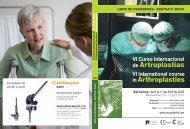cadera / hip - Active Congress.......
cadera / hip - Active Congress.......
cadera / hip - Active Congress.......
You also want an ePaper? Increase the reach of your titles
YUMPU automatically turns print PDFs into web optimized ePapers that Google loves.
MARTES / TUESDAY<br />
76<br />
The information suggests that excellent<br />
long-term results can be achieved with a<br />
well-conceived design and good surgical<br />
technique.<br />
OSSEOINTEGRATION IN<br />
PRIMARY CEMENTLESS<br />
HIP FIXATION<br />
J. D. Blaha, M.D.<br />
University of Michigan. Medical<br />
School, USA<br />
Osseointegration implies the formation of a<br />
“single” (i.e., integrated unit) between bone<br />
and, in the case of a joint replacement arthroplasty,<br />
a prosthetic component. Although it<br />
has not always been such in common usage,<br />
osseointegration and fi xation are synonymous<br />
terms. Fixation, for total joint replacement,<br />
implies that a prosthesis is bonded<br />
to the bone in such a way that there is no<br />
relative motion at the interface between the<br />
prosthesis and the bone. Osseointegration is<br />
a term that describes the histological features<br />
by which this fi xation is achieved and implies<br />
the mechanical features of a fi xed implant.<br />
Many total joint prostheses have been successful<br />
at the <strong>hip</strong>. There are numerous<br />
shapes and sizes of implants that have associated<br />
with successful clinical outcomes.<br />
The clinician is presented with a plethora<br />
of seemingly contradicting claims regarding<br />
the need for certain design features of<br />
implants in order to achieve a successful<br />
result. (E.g., “maximum fi t and fi ll”, porous<br />
coating, hydroxylapetite coating, “scratch fi t”<br />
grit-blasting etc.)<br />
This presentation suggests a unifying explanation<br />
for the success of implants. This<br />
explanation is based on dividing the time after<br />
implantation into four periods: primary stability,<br />
intermediate stability, secondary stability<br />
and long-term remodeling.<br />
Primary stability: For a cementless implant<br />
this period would be during the operative<br />
intervention when the prosthesis is inserted<br />
into the bone. The interference of the implant<br />
in the bone leads to a “press-fi t” that will hold<br />
the implant stable.<br />
Intermediate stability: For a cementless implant<br />
this period begins after primary stability<br />
is achieved in the OR and ends when bone<br />
apposition to the implant leads to secondary<br />
stability and osseointegration.<br />
Secondary stability: When bone apposition<br />
to the implant has progressed so that<br />
the implant has been “fi xed” (i.e., no relative<br />
motion at the interface of the implant to the<br />
bone) secondary stability has occurred. The<br />
time required to achieve this is not certain<br />
but bone healing is generally thought to take<br />
between 6 and 12 weeks.<br />
Long-term remodeling: The progressive<br />
change of bone at the interface to hypertrophy<br />
in areas of increased load and atrophy<br />
in areas of no load (i.e., the expression of<br />
Wolf’s law of bone) leads to this long-term<br />
remodeling. Other conditions at the interface<br />
(e.g., fracture, infection, debris induced bone<br />
resorption etc.) can lead to dissolution of the<br />
bone and loosening of the implant.<br />
In fact, this same concept can be applied to<br />
cemented arthroplasty as the ultimate fi xation<br />
of a cemented joint must be against live bone<br />
and the term osseointegration is appropriate<br />
for the cemented joint as well.





